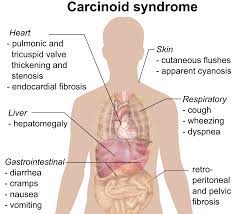INTRODUCTION:
Carcinoid syndrome is a rare condition that occurs in individuals with carcinoid tumors, which are typically slow-growing neuroendocrine tumors that develop in the gastrointestinal tract or lungs.
CAUSES
Carcinoid syndrome is primarily caused by the release of certain substances, such as serotonin, from carcinoid tumors. These tumors can be found in various organs, including the small intestine, appendix, colon, rectum, and lungs. When the tumors metastasize or spread, they can release hormones and bioactive substances into the bloodstream, leading to the characteristic symptoms of carcinoid syndrome.
SYMPTOMS OF CARCINOID SYNDROME:
The symptoms of carcinoid syndrome can vary among individuals and depend on the location of the tumor and the substances released. Some common symptoms include:
a. Flushing: Facial flushing, particularly of the cheeks, is a prevalent symptom of carcinoid syndrome. Flushing episodes may be triggered by certain foods, stress, or physical exertion.
b. Diarrhea: Persistent and watery diarrhea is another hallmark symptom. It can be accompanied by abdominal cramping and, in severe cases, lead to dehydration.
c. Wheezing and Breathlessness: Carcinoid tumors located in the lungs can cause wheezing, shortness of breath, and even asthma-like symptoms.
d. Heart Valve Abnormalities: Prolonged exposure to excess serotonin can lead to heart valve damage, resulting in a condition called carcinoid heart disease. Symptoms may include heart murmurs, heart palpitations, and edema.
e. Fluctuations in Blood Pressure: Carcinoid syndrome can cause episodes of low blood pressure (hypotension) or sudden spikes in blood pressure (hypertension).
DIAGNOSIS:
Diagnosing carcinoid syndrome can be challenging since its symptoms can resemble those of other conditions. Physicians typically perform various tests, including blood and urine tests to measure levels of serotonin and other hormones. Imaging studies such as CT scans, MRI, and octreotide scans may help locate and assess the extent of the tumors.
TREATMENT OPTIONS:
- The treatment approach for carcinoid syndrome involves a multidisciplinary approach, and it may depend on the size and location of the tumor, as well as the severity of symptoms. Treatment options include:
a. Surgical Intervention: Surgery may be performed to remove localized tumors or to debulk tumors that have spread to other organs.
b. Medications: Medications like somatostatin analogs, such as octreotide and lanreotide, can help control symptoms by inhibiting hormone release.
c. Targeted Therapies: Targeted therapies, such as tyrosine kinase inhibitors and mTOR inhibitors, may be used to slow tumor growth in cases where surgery is not feasible or tumors are resistant to other treatments.
d. Liver-directed Therapies: In cases where carcinoid tumors have metastasized to the liver, liver-directed therapies like embolization or radioembolization may be considered.
e. Symptom Management: Various approaches, including dietary modifications, anti-diarrheal medications, and supportive care, can help manage specific symptoms and improve quality of life.
CONCLUSION:
Carcinoid syndrome is a complex condition associated with carcinoid tumors. Although rare, it can significantly impact an individual’s quality of life. Early diagnosis, appropriate treatment, and ongoing symptom management play key roles in improving outcomes for patients with carcinoid syndrome. If you suspect you may have carcinoid syndrome or have concerns about this condition, it is essential to consult with a healthcare professional for accurate diagnosis and tailored treatment options.





